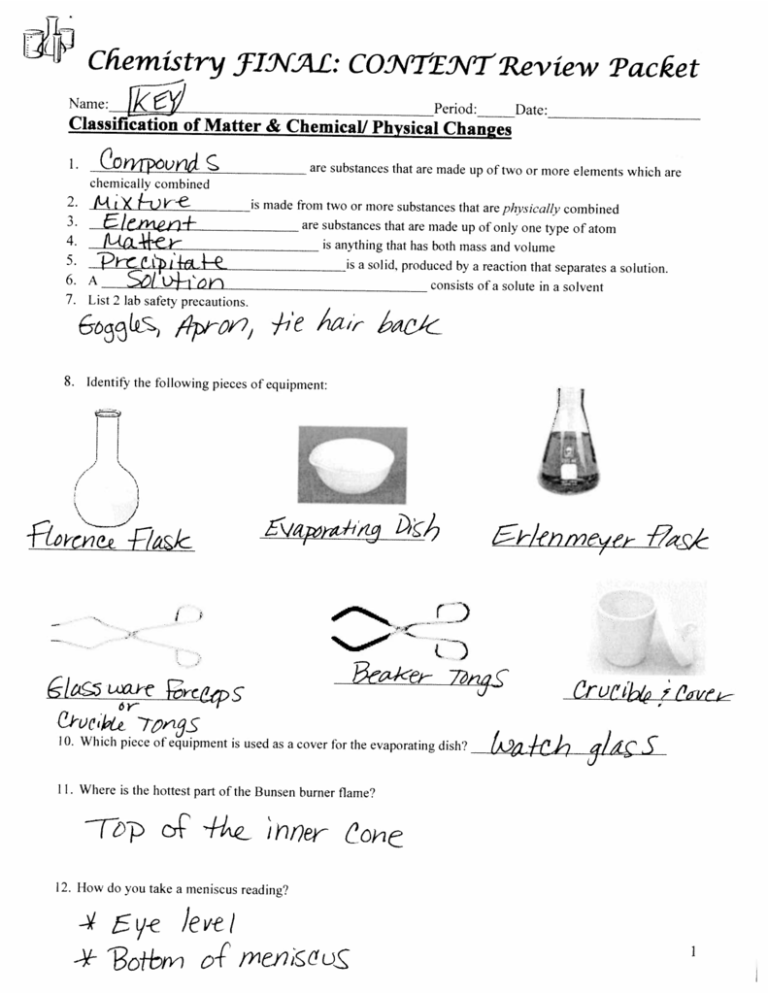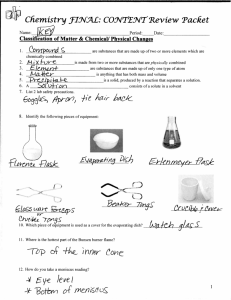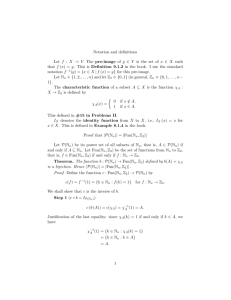A'r ji r/ Ii
advertisement

_____________Period:_____
___
chemIstry I!N4L: CO
IVT RevIew Packet
Name:_________________________
Classification of Matter & Chemical! Physical Changes
1.
i.1Pl._’YJ
chemically combined
Date:______________________
are substances that are made up of two or more elements which are
2. M-vv
is made from two or more substances that are phi sica/1i combined
3.
are substances that are made up of only one type of atom
4.
is anything that has both mass and volume
5.
is a solid, produced b a reaction that separates a solution.
6. A_______________________________ consists of a solute in a solvent
7. List 2 lab safety precautions.
A’r
1
oY
8.
ji
Identify the following pieces of equipment:
/
/
k- ;4
1
r
’.
or
71
1. q)
.
-
iqj
10. Which piece ofeuipment is used as a cover for the evaporating dish?
f7
J
11. Where is the hottest part of the Bunsen burner flame?
r/
CT
Ii
ifli2er eCk1
12. How do you take a meniscus reading?
II,p
L_-
I
I
(
-
-
c
*
1
brv
Y2jSL
I
___________________
13. Define what a heterogeneous mixture and a homogeneous mixture are and provide an example of
each.
(J
2S’
W2ihr,
14. Suppose that during a reaction a chemistry student touches the eaker and observes that it feels COLD. The
student should conclude that the chemical reaction is
F
Q
a’) Why?
+h.yr,i
;
L
1
ye
‘d
15. Suppose that during a reaction a chemistry student touches the beaker and observes that it feels HOT. The
student should conclude that the chemical reaction is
a) Why?
J’
)
/
I
16. Classify the following,
s an element, compound, homogeneous mixture or heterogeneous mixture.
1
a) Table salt
,/L
b) Aluminum________________________
c) Dirt___________________
d) Sugar water___________________
17. Define the terms chemical and physical change
12et
/UL)
M
1 8. C1assi1’ the following as ,hemica1 change or physical change.
a) Iron rusting
b) Ice melting_______________________
‘
c) Evaporation
ph y
r
d) HC1 reacting with Mg to create H
2 gas
/
19. Another name for a homogeneous mixture is a(n)
20. What are four indicators of a chemical reaction?
I,
=
(±-
1)
1/
7jf
1’L’ 7’ ‘j/’”
Z)
iJc/
c)
/
i_
.2
2FLaf?
/;
.
L
___________
___________
___________
___________
___________
__________
__
___
Measurement & Density
1, What is the difference between a qualitative measurement and a quantitative measurement?
/1i
2. mL
“
;/Lii
iJ
I
is a unit that measures
3. crn” is a unit that measures
ç
4. g” is a unit that measures
c
5. “mm Hg” is a unit that measures
6. K” is a unit that measures
7. What is the difference between accuracy and precision?
.2
acpd
C(cs-e
1
V
ô-P eco
/
8. Try these conversions:
a.
500Omg
b. 1L
9. Write the following numbers in scientific notation.
7. 1
a. 746O0 n
X7
b. 0.0443km
10, Write the following numbers in ordinary notation.
a. k
7
8.S
m_________
xlO
_______
0.
h. 4
9.67x10
k
m
OOd17
11. Define density.
j
—
12. Find the density of an unknown solid given that a 5.62g sample occupies 2.35 cm
3
f_
/ )
122%3
__________
Atomic Structure, Quantum Numbers, and Electron Notation
___..z___
1. proton
a. the total number of protons and neulrons
in the nucleus of an atom
b. the weighted average mass of the atoms
in a naturally occurring sample of an element
c. 1/12 the mass of a carboni2 atom
d. the number of protons in the nucleus of an
element
e. atoms with the same number of protons
but different number of neutrons
f. negatively charged subatomic particle
g. the smallest particle of an element that
retains the properties of that element
h. a counting unit; 6,022 x 1 0
i. positively charged subatomic particle
j. subatomic particle with no charge
2. atom
3. mass number
4. atomic mass unit
4
5. electron
6. mole
7. average atomic mass
8. atomic number
9. neutron
10. isotopes
1.
Suppose an atom has 27 protons and 32 neutrons. What is the mass number?
2.
Suppose an atom has 29 protons and 35 neutrons. How many electrons does it have?
2
/
3. Suppose an isotope has a mass number of 27 and an atomic number of 13.
a.
Write the hyphen notation for this isotope.
-2’l
b. Write the nuclear symbol for this isotope.
41
4. What is electromagnetic radiation? Provide examples.
2
a,
:
,
/
v1A,
k
j, /y 4t
-/c
vi C/-S ;
/1t&
)nis
.
i
iii
vCS
5. Wht is the BEST way to describe the nature of an electron?
/e
A
AiLJ7
6. Fill in the chart below. What do the four quantum numbers indicate?
Angular Momentum Quantum Number
Magnetic Quantum Number
Spin Quantum Number
•ci•e ‘-? (PEJ
Y/cL/-i
Ep ir 4
o- M/
1
t
c
i
4
2
7. One orbital can hold a MAXIMUM of
electrons.
8. What it the correct electron configuration notation and orbital notation for Na and Al
Diagonal Rule:
A
i
2
252
A
32
A
A
52
2
6
A
5
pL&
6
2p
‘
/
f;2.
3p
6
6
4p
5p
6p
3d
°
1
4d’°
5dt
ód’°
Z
75
2
4f
14
5 14
3.. . .
i (‘&
A
/>
Z
5.._
p
0
Periodic Table
1.
AM2jj/,,/1L c
are elements that show the properties of both metals and nonmetals.
2. How are elements arranged on the Periodic Table?
71 ,
7ki
3. What is electronegativitv?
flrs
2.
h
a
ZiY2
/
i2 e
4. What is the most electronegative element?
5. Write whether an increase or decrease of a trend occurs as you go across the Periodic Table from
to right in a period, and when you go from p to bottom in a group.
Trend
Across a Period
1 St Ionization Energy
Atomic radius
Electronegativity
1
1
Down a Group
icfi
What name is given to the following?
6.
a.
Group #1 Elements:
b
Group #2 Elements
c.
Groups #3-12 Elements:
d.
Group #18 Elements:
e.
Group #17 Elements:
/
/7v4
Ic
,
7. Use the elements from part of period three. listed below, to answer the following questions. Write the
symbol of the element described in the blank provided. (lpt.each)
11
12
Na
Mg
Al
Si
P
S
Cl
Ar
22.99
24.30
26.98
28.09
30.97
32.07
35.45
39.95
13
14
a). an element ith 15 electrons
15
16
17
18
i). an element in the same group as potassium (refer to
wall chart to find potassium-K)
ili& b). the most reactive metal
r
c). the most reactive nonmetal
a
d). an element with 12 protons
j). an element that forms an ion with a charge of—2
k). an element with a atomic number of 14
e). an element with the atomic number of 17
-h’
f). the MOST stable element
j,4
h). an element in the halogen group
Bonding
1.
A bond where there is a sharing of electrons:
a) mutual
2.
b) electronegativity ova1jjt_
d) ionic
A bond where there is transferring of electrons so an attraction between positive and negative ions is
established:
a)
h) electronegativitv
mutual
c) covalent
3. What is the difference between nonpolar covalent and polar covalent bond type?
L
1jl1L/’
4. How many valance electfons are found in the following groups?
a.
b.
c.
d.
e.
f.
g.
h.
Group
Group
Group
Group
Group
Group
Group
Group
1
(
2
7_
13
14
15
16
1
18
6
up
5. Circle the lone pair electrons in the following dot formula of water.
6. With respect to bonds fonned between the following pairs of atoms:
•
•
•
Determine the electronegativity difference. SHOW WORK!
Determine the probable bond type (ionic, polar covalent, or nonpolar covalent).
Assign partial charges to atoms that are part of a polar covalent bond.
Pairs of
Atoms
Electronegativity
Difference
/
Handil
/
—
Probable
Bond Type
Partial Charge (if
polar-covalent)
—:
5
Z5—
L
o
3-
SandO
KandBr
/?
—
—i
i-oisc
,.
C* L)
7. A molecule is a
of atoms held to together by
L bonds.
(JflJZ IJ-3 7
8. What is the difference between a cation and an anion?
;::t:•
iEc2fr
/I
II
2/C
i
l
e
z,
/;
9. List the naturally occurring diatornic elements?
1
2_
j
10, What is the molecular geometry of BF
3
(72L
k_
/k’ze2
11. What is the molecular geometry of Cl-I
4
12. What is the molecular geometry of CO
2
/
r
1*
L=c=1
7
_______
14. A substance that increases the rate of a reaction without itself being changed is a(n)
a) precipitate
catalyst
c) inhibitor
d) none of the above
15. What is a reversible reaction? Flow is a reversible reaction represented.
Ciô
16. Label the products, reactants and yields arrow.
V1
4
CH
+
202
2
CO
+
0
2
2H
1 7. Fill in the correct symbol that would used when writing a chemical equation based on the meaning provided.
Meaning
Symbol
“yields”; indicates result of a reaction
Indicates a reversible reaction
A reactant or product in the solid state
,
j
a
Alternative to (s); used only for a precipitate (solid) falling out of solution
A reactant or product in the liquid state
A reactant or product in aqueous solution (dissolved in water)
A reactant or product in the gaseous state
j%
Alternative to (g); used only for a gaseous product
Reactants are heated
Zi
Pressure at. which the reaction is carried out, in this case 2
Temperature at which reaction is carried out, in this case 0°C
A catalyst is used to speed up the reaction rate, in this case Mn02 would be used
_______________________ to speed up the reaction rate.
9
Kinetic Theory, Solids, Liquids, Gases, Phase Changes
Name the S parts of the kinetic molecular theor.
•re
11
2.
of
/ p{c
ON
Pa.r+j
S
/1Y2
//7
9V /
/1i c
How does temperature affect the kinetic energy of a substance?
j
17
If
3.
List the values for SIP.
C;C 2Rk
‘Y: 1
7&•..•
4.
I
OThrn
/D/;;
If the volume of a gas is decreased, then gas pressure will_____________
5. If the volume of a gas is increased, then gas temperature will
Zi PiS?
6. How does evaporation differ from sublimation?
/
I’ q
7. Complete the chart to name the four phases of matter and compare their volumes, shapes, and average
kinetic energy
Phase
Liquid
Shape
Volume
/?)
// J
definite
definite
definite
Not definite
/
I
1
t
>/
Not definite
?
Average Kinetic Energy
I
Very FAST (violent)
Fast
/-(1ii
8. What is the difference between a crystalline solid and an amorphous solid?
1
L
17
9
-t
Y?+ p/--
1id
dJ
9. Which of th 4 phases of matter is considered to have the most significant intermolecular forces?
a) The least sigmikant mtermolLLular forces
0
10. A liquid will boil when its equilibrium vapor pressure EQUALS
11. When a system at equilibrium is disturbed by aipn
minimizes the stress. This is known as
Ij’ I
of a stress,
(I
it attains a new equilibrium position that
.
10
12. Use the phase diagram below to answer the following questions:
a.
C
h. The area on the graph that represents the liquid phase is:
E
c.
The area on the graph that represents the solid phase is:
The area on the graph that represents the gas phase is:
1B
d. When does the triple point occur?
fr
1
O
anr
e. What happens o a substance as you move from point A to point
B?_______________
10 20 30
Mixtures: Solutions, Suspensions & Cofloids
1.
0 90 110 130
TrC)
Define the following terms: solution. colloid. suspension
aZs/E’:L
m/Jç.
2.
Suppose 15 g of sugar is dissolved in 1000 g of water. The sugar is the&t4i and the water is thec /ki
3.
Explain what the phrase “like dissolves like” means and give an example
5(vv &i-
5v1cp
h. c1
iQLV
dt;-’cs
K
4. Explain the difference between an unsaturated, saturated and a supersaturated solution. Define these terms!
Th
I’cue uc1 io! 4
ii
L ./5
—
C),
5. What 3 things can increase the rate at which a solute will dissolve?
7
7. How could you identify a colloid?
i.
..‘/
1LI /, I
IT I,ii-
/? LI
2
I
i-
i
/1
/7i
/1
.
-i
Acids/Bases/Salts
1.
Describe acids and bases according to the theory of Arrhenius.
I
-
,2ter
-
2.
Explain how blue and red litmus paper determine if a substance is an acid, base or salt.
i<& ;
3.
/c
‘4
k,,!
—
Explain the process of neutralization using a chemical equation.
Ac1
4.
-
-
&
/v4
LJ
...
.
Define pH and draw the pH scale showing the locations of acids. bases, and neutral substances.
7
2M::
ftt’1/
5.
What happens during a splint test? How do you know 02. CO
2 or H
2 is produced?
!c
Jo/oJ
/i/
c/i’- t— a
/v
-
-
z
0
PhL 9,ç
z’/àVL
,-/)1
2JI
?/‘ S2I
uclear Chemistry
1. Name and describe each of the 3 types of radiation.
z
/
/
/
/c
/
/L//
2. What is a half-life?
y......,P
7
L2.L
3. Write the nuclear symbol and the hyphen notation for an isotope of phosphorus with a mass number of 32.
32
/
,
12
4. What is the difi’erence between fission and fusion?
•Si
1
iY
•&
5. Balance the following nuclear reactions.
2fn
2
P
b
+
He
zth
+
4He
-
2
P
o
—
I Things to study:
ALL Notes
o Labs
o Review Guides (Content & Math)
o Mrs. t
Hostetter website (review PowerPoints)
s
o www.epasd.org/hostetter
o
I
I
I
The ACCUMULATIVE Final Is Worth 100 points:
o 100 multiple choice questions
STUbY&G00t LUCK!!
ii
Ii
Chemistry I
ND4L: MATh Review
4
Name:
1. Calculate the molar mass of iron (IL) phosphate. 358g
3 (3
22.
Period:
Date:________________
(‘83
Zq
f39
Find the percent composition of sodium carbonate.
Na,%cj4
f\jtZ CO
3
5%
x
2(
)(iz
3(14
ULi
O]
3.
Convert 6.25 g of sdium c’loride to moles. O.1O8m
4.
Convert 0.500 mol of potassium iodide to grams. 83g
5.
What is the empirical and molecular formula of a compound with the following percent composition:
p 26.7 %, N = 12.1 %, Cl 61.2 %. The molar mass of the compound is 695 g/mol.
/
2
PM i
EFNc!MFf6N6c!12
,
8/i O/mo/’ /
il-I
/j
LJh
/
I
I11 ,q1’
zHO/
I
c’
’21J,
1
‘&‘f
ta;
2
/15
6.
fJdt/
2
How many grams of sodium phosphate are needed
A/ad1
to completely react with 25.0 g of barium chloride?
13.205g
/nlO/
7.
C/
Suppose 100 rnL of solution contains 5.92 g of dissolved calcium chloride. Calculate the molaritv. 38M
ivi/ oa/&k
£
F1-;ôii
f1ZfL
8.
/,‘
Suppose 9.56 g of sodium hydroxide is dissolved in 150. g of water. Calculate the molality.
DID NOT COVER!!
9.
Write the electron configuration notation, orbital notation, and electron dot symbol for arsenic.
As= 33
e
/5Zlcl323?
10. Suppose a gas is collected in a 145 mL flask where the temperature of the gas is 23°C and the pressure of the
gas is 785 mm Hg. Calculate the volume of the gas at STP, 3384 2mL
/‘7/?i L
273k
76>/
—if A
Ii il,i
46i
y
1
ICJ
i
2
i
11. Suppose 25.0 ml. of a gas is at 24°C. Calculate the temperature at which the gas will occupy 30.0 mL
assuming constant pressure. 356.4K
1
\J
;
2-
\J 2L
V
Z?7)
12. Suppose the length of a piece of string is measured to be 33.45 cm. Calculate the percent error if the string is
wly 3450 cm long. 3O4%
3?35J
/
Ep -11t-j
,I
flteor-
/
13. Suppose 4.25 g of sodium chloride is collected after a chemical reaction. Through stoichiornetry calculations it
is determined that the theoretical yield of sodium chloride is 5.00 g. Calculate the percent yield. •4
y
7/CO
42
rkeOrc7traJ
1
Q31
14. Suppose an unknown radioactive substance with a mass of 120 g has a half-life of 6 months. How much of the
substance will remain after 2 years? 7.5g
hi-
/
hf
O vrS
4LL L
4CZ
3
2.
I
yrc
I
\ hat is the olume of 10 5 got copper (The denslt\ ot copper is 894 gem )
3
1_17c!
/24SS
tUiYL-
:
173
13







